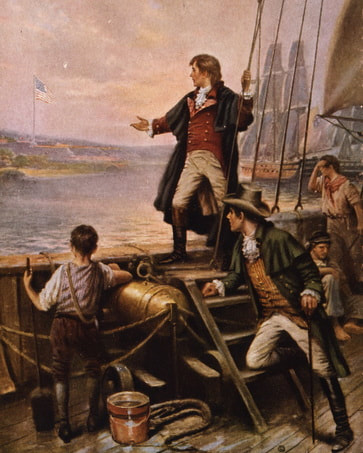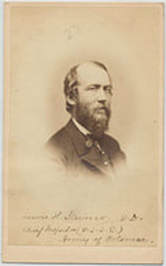MOUNT OLIVET CEMETERY and FREDERICK, MD
-A bonafide "Home of the Brave"
 Just outside the cemetery's front gate, "Echo Taps" organizer Fred Schumacher pays respect to all veterans, past and present, through his trusty instrument.
Just outside the cemetery's front gate, "Echo Taps" organizer Fred Schumacher pays respect to all veterans, past and present, through his trusty instrument.
The United States flag is around us everywhere….and Frederick's Mount Olivet Cemetery is no exception. One doesn't have to look hard to find our red, white and blue national, and cultural, icon floating on a light breeze. The flag is especially visible on specific holidays steeped in the tradition of flying flags and giving rise to the wearing of the “Stars & Stripes” on one’s own person.
Memorial Day, Flag Day (June 14), and the 4th of July annually frame a six-week “gauntlet of patriotism" during the summer. Sometimes overlooked, a day of equal importance is November 11th of each year—Veterans Day. We are honored to have Frederick's annual "Echo Taps" event start at our front gate each November 11th.
Veterans Day has its origins in Armistice Day, a holiday still celebrated in other countries such as England, France, Belgium, Canada, and Scotland, and marks the anniversary of the end of World War I. The reason for this date-- major hostilities of World War I were formally ended at the 11th hour of the 11th day of the 11th month of 1918, when the Armistice with Germany went into effect. The United States previously observed Armistice Day, but renamed the observance Veterans Day in 1954 at the end of the Korean War.
Veterans Day honors all military veterans, persons who have served in the United States Armed Forces and differs from Memorial Day where the commemoration is focused on just those who lost their lives while in military service. These men and women, living and deceased should always be revered as brave defenders of the flag. Mount Olivet Cemetery is the eternal home to thousands of US veterans of these 20th century world conflicts. Here, one can also find early patriots such as Thomas Johnson, Jr. and Sons of Liberty who took up arms in the Revolutionary War for American Independence.
In fact, over 10% of our total population of 40,000 interred were veterans. This is astounding, considering that at least half of our population consists of females who, in earlier times, could not, or would not, participate in the military. A pioneering "cemetery resident" who did serve was Charlotte Berry Winters. Ms. Winters joined the US Navy in 1917 as a yeoman. At the time of her death in 2007, she was the oldest surviving female veteran of World War I at the age of 110.
Memorial Day, Flag Day (June 14), and the 4th of July annually frame a six-week “gauntlet of patriotism" during the summer. Sometimes overlooked, a day of equal importance is November 11th of each year—Veterans Day. We are honored to have Frederick's annual "Echo Taps" event start at our front gate each November 11th.
Veterans Day has its origins in Armistice Day, a holiday still celebrated in other countries such as England, France, Belgium, Canada, and Scotland, and marks the anniversary of the end of World War I. The reason for this date-- major hostilities of World War I were formally ended at the 11th hour of the 11th day of the 11th month of 1918, when the Armistice with Germany went into effect. The United States previously observed Armistice Day, but renamed the observance Veterans Day in 1954 at the end of the Korean War.
Veterans Day honors all military veterans, persons who have served in the United States Armed Forces and differs from Memorial Day where the commemoration is focused on just those who lost their lives while in military service. These men and women, living and deceased should always be revered as brave defenders of the flag. Mount Olivet Cemetery is the eternal home to thousands of US veterans of these 20th century world conflicts. Here, one can also find early patriots such as Thomas Johnson, Jr. and Sons of Liberty who took up arms in the Revolutionary War for American Independence.
In fact, over 10% of our total population of 40,000 interred were veterans. This is astounding, considering that at least half of our population consists of females who, in earlier times, could not, or would not, participate in the military. A pioneering "cemetery resident" who did serve was Charlotte Berry Winters. Ms. Winters joined the US Navy in 1917 as a yeoman. At the time of her death in 2007, she was the oldest surviving female veteran of World War I at the age of 110.
 Francis Scott Key gazes upon the "Star-Spangled Banner" flying atop Baltimore's Fort McHenry
Francis Scott Key gazes upon the "Star-Spangled Banner" flying atop Baltimore's Fort McHenry
No country loves their flag more than the United States, this is widely known. And no town loves the faithful “red, white and blue” more than Frederick, Maryland. In fact, a handful of former Fredericktonians, known nationally (and internationally) have the flag to thank for their immortal rise to fame. Each are considered heroes in their own right, accomplishing something amazing while adjacent a U. S. flag under attack by a warring enemy. Francis Scott Key is revered as one of the heroes of the War of 1812, and resides in historic Mount Olivet Cemetery. As a matter of fact, his elaborate grave monument greets lot-holders and visitors alike as they enter the cemetery's front gate. Key was not an officer, and a marginal soldier at best. However, he put pen to paper “at the dawn’s early light” after seeing the flag flying atop war-torn Fort McHenry on September 14th, 1814, thus giving us four stanzas of verse. Key’s “Star-Spangled Banner” would eventually become our country’s national anthem.
While visiting Frederick on August 6, 1834, Francis Scott Key made a speech at Courthouse Square during a large ceremonial banquet. Many veterans of the War of 1812 were in the audience and this would be one of a few rare occasions in which Key discussed his remembrances associated with writing the Star-Spangled Banner. Key would give credit to these former soldiers:
"The song, I know, came from the heart, and if it has made its way to the hearts of men, whose devotion to their country and the great cause of freedom I know so well, I could not pretend to be insensible to such a compliment.
With it came an inspiration not to be resisted; and even though it had been a hanging matter to make a song, I must have written it. Let the praise, then, if any be due, be given. not to me, who only did what I could not help doing; not to the writer, but to the inspirers of the song!”
…I again thank you for the honor you have done me; but I can only take the share of it. I was but the instrument in executing what you have been so pleased to praise; it was dictated and inspired by the gallantry and patriotism of the sons of Maryland. The honor is due, not to me who made the song, but to the heroism of those who made me make it…
Nearly fifty years after the penning of the "Star-Spangled Banner," another interred resident of Mount Olivet would defend the flag and her beloved "boys in blue." This was not a soldier, but a humble female resident of town. Barbara Fritchie's alleged flag-waving exploits in the face of an invading Confederate Army helped re-energize both Union soldiers, fellow citizens and countrymen throughout the North. John Greenleaf Whittier’s popular poem gave posthumous immortal fame to the local heroine, but more importantly, painted Frederick-Town and its “clustered spires” as a place of patriotism and allegiance to the flag.
 Dr. Lewis H. Steiner
Dr. Lewis H. Steiner
Two neighbors of “Dame Fritchie” served proudly for the Union, each hailing from some of Frederick’s founding German families: the Schleys and Steiners. Although named for a famed Army general, Rear Admiral Winfield Scott Schley would enjoy a much decorated career in the United States Navy. After graduation from the Academy in Annapolis, Schley aptly found himself in naval service during the Civil War. His greatest moment however, came more than three decades later in Santiago, Cuba during the Spanish-American War. Here he commanded his squadron’s flagship, “the U.S.S. Brooklyn” and is credited for destroying the Spanish fleet under Admiral de Cervera. Schley’s autobiography, published in 1904, is entitled Forty-five years Under the Flag. Admiral Schley's body was laid to rest in Arlington Cemetery, however his parents, siblings and countless other relatives reside at Mount Olivet. Of equal importance are other veterans connected to the Spanish-American War of the late 1890's, including men like Jesse Claggett (1851-1911) who fought with Teddy Roosevelt and his famed "Roughriders." In addition, a captured gun from the Spanish fleet was on display for many years at the foot of the Francis Scott Key Monument.
Dr. Lewis H. Steiner did not achieve the iconic fame of the other three Fredericktonians, but certainly made a name for himself through his leadership of relief efforts under the flag of the United States Sanitary Commission. He rose quickly through the ranks of the commission to become Chief Inspector for the Army of the Potomac. Although Dr. Steiner served in the healing side of the Army, he certainly had the militaristic spirit in his blood. His grandfather had commanded a Frederick artillery unit in the 1812 conflict, and his great uncle was captain of a Frederick infantry unit.
Dr. Steiner's son, Bernard Christian Steiner, would serve as master of ceremonies at the dedication of the Francis Scott Key Memorial in 1898.
Dr. Lewis H. Steiner did not achieve the iconic fame of the other three Fredericktonians, but certainly made a name for himself through his leadership of relief efforts under the flag of the United States Sanitary Commission. He rose quickly through the ranks of the commission to become Chief Inspector for the Army of the Potomac. Although Dr. Steiner served in the healing side of the Army, he certainly had the militaristic spirit in his blood. His grandfather had commanded a Frederick artillery unit in the 1812 conflict, and his great uncle was captain of a Frederick infantry unit.
Dr. Steiner's son, Bernard Christian Steiner, would serve as master of ceremonies at the dedication of the Francis Scott Key Memorial in 1898.
All of these former residents of Frederick were well acquainted with the Frederick Barracks located on the campus of the Maryland School for the Deaf. Erected during the Revolutionary war for the purpose of housing military prisoners (both British and Hessian), this historic structure never came under attack by the enemy. However, it has proudly stood under a “Star-Spangled Banner” for its entire existence, witnessing the drilling and mustering of local militia companies in various conflicts. It also housed Union General Hospital #1, consisting of Civil War medical staffs caring for the wounded and sick of both armies.
One block to the south, Mount Olivet Cemetery has been a safekeep of local veterans who unselfishly traveled the country, and/or world, in an attempt to protect our flag, our "Star-Spangled Banner," and the freedom and independence we have continued to enjoy since 1776.
One block to the south, Mount Olivet Cemetery has been a safekeep of local veterans who unselfishly traveled the country, and/or world, in an attempt to protect our flag, our "Star-Spangled Banner," and the freedom and independence we have continued to enjoy since 1776.





